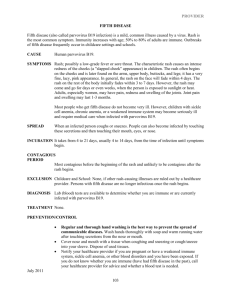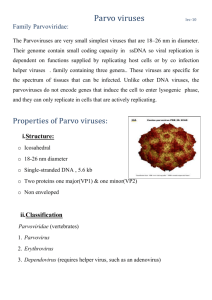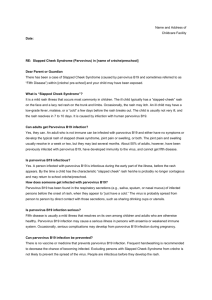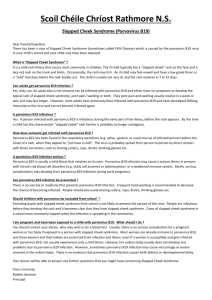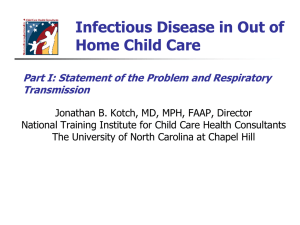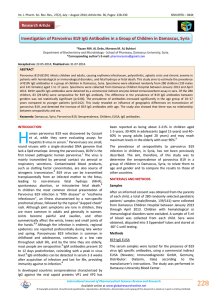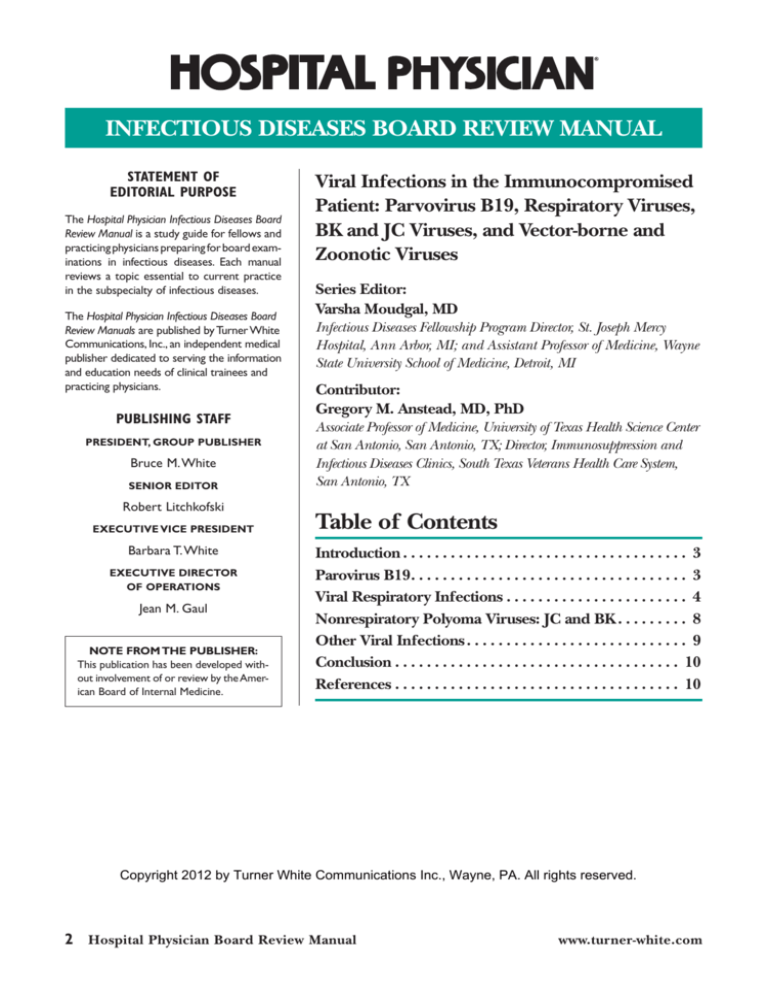
Infectious diseases Board Review Manual
Statement of
Editorial Purpose
The Hospital Physician Infectious Diseases Board
Review Manual is a study guide for fellows and
practicing physicians preparing for board exam­
inations in infectious diseases. Each manual
reviews a topic essential to current practice
in the subspecialty of infectious diseases.
The Hospital Physician Infectious Diseases Board
Review Manuals are published by Turner White
Communications, Inc., an independent medical
publisher dedicated to serving the information
and education needs of clinical trainees and
practicing physicians.
PUBLISHING STAFF
PRESIDENT, Group PUBLISHER
Bruce M. White
Senior EDITOR
Robert Litchkofski
executive vice president
Barbara T. White
executive director
of operations
Jean M. Gaul
NOTE FROM THE PUBLISHER:
This publication has been developed with­
out involvement of or review by the Amer­
ican Board of Internal Medicine.
Viral Infections in the Immunocompromised
Patient: Parvovirus B19, Respiratory Viruses,
BK and JC Viruses, and Vector-borne and
Zoonotic Viruses
Series Editor:
Varsha Moudgal, MD
Infectious Diseases Fellowship Program Director, St. Joseph Mercy
Hospital, Ann Arbor, MI; and Assistant Professor of Medicine, Wayne
State University School of Medicine, Detroit, MI
Contributor:
Gregory M. Anstead, MD, PhD
Associate Professor of Medicine, University of Texas Health Science Center
at San Antonio, San Antonio, TX; Director, Immunosuppression and
Infectious Diseases Clinics, South Texas Veterans Health Care System,
San Antonio, TX
Table of Contents
Introduction. . . . . . . . . . . . . . . . . . . . . . . . . . . . . . . . . . . . . 3
Parovirus B19. . . . . . . . . . . . . . . . . . . . . . . . . . . . . . . . . . . . 3
Viral Respiratory Infections. . . . . . . . . . . . . . . . . . . . . . . . 4
Nonrespiratory Polyoma Viruses: JC and BK. . . . . . . . . . 8
Other Viral Infections. . . . . . . . . . . . . . . . . . . . . . . . . . . . . 9
Conclusion. . . . . . . . . . . . . . . . . . . . . . . . . . . . . . . . . . . . . 10
References. . . . . . . . . . . . . . . . . . . . . . . . . . . . . . . . . . . . . 10
Copyright 2012 by Turner White Communications Inc., Wayne, PA. All rights reserved.
Hospital Physician Board Review Manual
www.turner-white.com
Infectious Diseases Board Review Manual
Viral Infections in the Immunocompromised Patient:
Parvovirus B19, Respiratory Viruses, BK and JC Viruses, and Vector-borne and Zoonotic Viruses
Gregory M. Anstead, MD, PhD
INTRODUCTION
In part I of this 2-part series on viral infections in immunocompromised hosts, infections due to the various
herpesviruses were described. This part addresses viral infections due to parvovirus B19, adenovirus, the traditional
respiratory viruses (respiratory syncytial virus, rhinovirus,
and the influenza and parainfluenza viruses), the newly
emerging respiratory viruses (human metapneumovirus,
bocavirus, and the corona- and polyomaviruses), the BK
and JC viruses, West Nile virus, and the zoonotic viruses
(rabies and lymphocytic choriomeningitis viruses). For
many of these viruses, readily accessible diagnostic testing
was not available until the last decade. With the exception
of influenza, these viruses differ from the common herpesviruses in that prophylaxis and treatment regimens
are poorly defined. However, infection from many of
these viruses can be prevented by infection control measures and careful donor selection.
PARVOVIRUS B19
Parvovirus B19 infection occurs worldwide, and
there is a high seroprevalence in adults (60%–90%).1
The virus is typically transmitted by the respiratory
route, although transmission by blood products and
from transplanted organs also occurs.2,3 The replication of parvovirus B19 requires actively dividing cells,
such as erythroid precursor cells.4 B19 is associated with
several diseases, including hydrops fetalis, erythema
infectiosum, and arthropathy. In immunocompromised
patients, aplastic crisis is the most common presentation, but hepatitis, vasculitis, and myocarditis have also
been reported.4 In HIV patients, a diagnosis of B19 is
most likely in patients with severe anemia (hematocrit
<24%), a CD4 count below 100 cells/µL, and the absence of reticulocytes.5 In a study of 98 cases of B19
infection in transplant patients, anemia, leukopenia,
www.hpboardreview.com
and thrombocytopenia were present in 98.8%, 37.5%,
and 21%, respectively. Other manifestations included:
flu-like illness, rash, and arthralgia. Hepatitis, myocarditis, glomerulopathy, and pneumonitis were rarely
observed. Three patients died of B19 myocarditis. The
characteristics of hepatitis, pneumonitis, and myocarditis due to B19 are not well described. Allograft
rejection, dysfunction, or loss occurred in 10.4% of
transplant patients infected with B19.6
Thrombotic microangiopathy due to B19 has been
observed in renal transplant recipients, with findings of
elevated serum lactate dehydrogenase (LDH), thrombocytopenia, and hemolytic anemia.7 B19 is also a contributor to transplant coronary artery disease in pediatric cardiac transplant patients.8 In addition to primary infection,
reactivation of latent B19 infection may occur. Because of
the various modes of transmission and reactivation, the
timing of B19 infection ranges from early post-transplantation to years after transplantation; however, most cases
occur within the first 3 months after transplantation.3
The most sensitive test for detecting B19 infection
is polymerase chain reaction (PCR) assay of blood or
bone marrow specimens. A bone marrow biopsy with
pure red cell aplasia is suggestive of B19 infection.6
Evidence for allograft-mediated transmission includes
early onset after transplantation and detection of parvovirus DNA in donor serum or tissues or high IgM
antibody titers in donor sera.3
There is no specific prophylaxis against parvovirus
B19. The treatment of B19 disease in transplant patients is reduction of immunosuppression and administration of intravenous immunoglobulin (IVIG) at a
dose of 400 mg/kg/day for 5 days.5 In transplant patients, the rate of recurrence of B19 disease after IVIG
treatment was 23.2%.6 In HIV patients, anemia due
to B19 may dramatically improve within months after
starting highly active antiretroviral therapy (HAART),
obviating the need for IVIG. Nevertheless, some HIV
patients with B19 infection may have persistent anemia
despite HAART and may also require IVIG.9
Infectious Diseases Volume 13, Part 4


